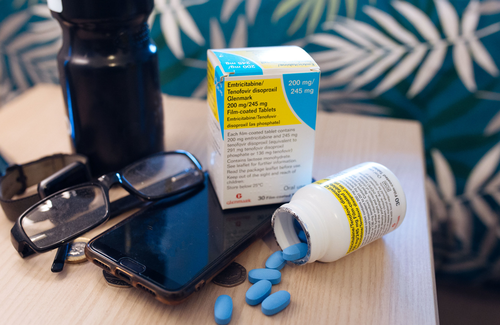
Less than half of individuals diagnosed with STIs or other markers of HIV risk accepted an active offer of PrEP, according to Canadian research published in AIDS and Behavior. Offers of a PrEP referral were made by nurses to people diagnosed with rectal STIs, syphilis, sexual contact with an HIV-positive individual and also those who had used a course of HIV post-exposure prophylaxis (PEP). However, only 48% accepted the offer of PrEP. Commonly cited reasons for refusal included lack of perceived HIV risk, lack of interest in PrEP, an inability to manage the treatment and negative perceptions of the safety and tolerability of the medication.
“Many patients did not view themselves as being sufficiently at risk of HIV to warrant PrEP, not withstanding risk factors that correlated with elevated HIV incidence,” comment the authors. “This finding highlights the need for more research about people’s perceptions of HIV risk and PrEP, and how, when, and why these feel this intervention would be necessary.”
Despite the uptake rate, the investigators calculated that their pro-active offer of PrEP would have prevented several HIV infections.
Dr Patrick O’ Byrne and colleagues of the School of Nursing at the University of Ottawa, wanted to see if specialist nurses could increase uptake by proactively offering PrEP to people with evidence of high HIV risk who attended STI clinics.
They presented findings on individuals using their service between August 2018 and August 2019. They analysed the details of the individuals meeting their criteria for PrEP referral, the rate of PrEP acceptance and they examined patients’ notes to identify reasons why the offer of PrEP was declined.
PrEP was proactively offered to individuals diagnosed with syphilis, rectal gonorrhoea or chalmydia, and also people who had taken a course of PEP or who, in the jugdement of the nurse practitioner, were at high risk of contracting HIV.
Nurses identified 340 individuals who met these criteria. Almost all (98%) were men. Approximately a quarter were ineligible for PrEP because of medical reasons (for example, they were HIV-positive or were already taking PrEP) or problems with health insurance. This left 261 eligible individuals, of whom 48% accepted a PrEP referral.
Three people meeting the criteria were subsequently diagnosed with HIV. One of these diagnoses was in a man who twice declined PrEP after being diagnosed with syphilis and a rectal STI. Another individual accepted the referral after multiple STI diagnoses but never started PrEP. The third person was found to be HIV positive at baseline.
All the individuals declining PrEP were male and had an average age of 35 years. The referral acceptance rate was lowest among individuals diagnosed with rectal gonorrhoea/chlamydia (30%) and highest among those who, in the judgement of the nurse practitioner, were at risk of HIV (55%).
“While our acceptance rate was below 50%, we nevertheless feel that our program was successful because the 124 patients who accepted a referral initiated PrEP when they otherwise might not have,” write O’Byrne and colleagues. “These 124 individuals did not seek PrEP, but agreed to use it after nurses raised the idea. As the number needed to treat to avert one HIV infection ranges from 20 to 40 in the PrEP literature, this uptake could mean that 3-6 HIV cases were averted during our 1-year study period.”
The most common reason given for declining a PrEP referral was lack of self-perceived HIV risk (42%). There was a consistent belief that PrEP was for people having anal sex without condoms with multiple, non-regular partners. For instance, one individual stated: “I’m not at risk. I’m not normally like this”; this was despite a syphilis diagnosis and two diagnoses of rectal chlamydia. People declining PrEP often saw their current level of risk as being atypical – they simply did not see that their behaviour warranted PrEP.
"People declining PrEP often saw their current level of risk as being atypical."
Approximately a quarter of those declining PrEP said they were not interested in taking it. This group included individuals who declined PrEP outright and also people who needed time to think. Of the latter group, four individuals did indeed return and accept the offer of PrEP, suggesting that the initial timing of the PrEP offer just wasn’t right.
A third major reason for declining the referral was a perceived inability to manage PrEP (14%). One man said he “needed to get things in my life in order first”. Individuals mentioned factors including mental health, travel plans and fears about the cost of the treatment.
The final reason for refusal was negative perceptions of PrEP, especially about the treatment being “harmful” or “toxic”. Some people were concerned that other people (such as an employer) would find out about their use of PrEP and so they would be viewed as a person with risky behaviour.
Taken together, the investigators think that reasons for declining PrEP “suggest persistent beliefs about HIV prevention services as an indication of risk-taking behaviour. It also highlights ongoing beliefs about the harmfulness of HIV medications, generally, and the stigma that surrounds these interventions.”
Tailoring the offer of PrEP to individual circumstances could increase its uptake, conclude O’Byrne and colleagues.
O’Byrne P et al. Active-offer nurse-led PrEP (PrEP-RN) referrals: analysis of uptake rates and reasons for declining. AIDS and Behavior, online ahead of print, 2019 (open access).

